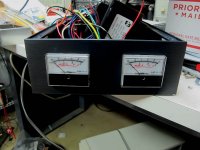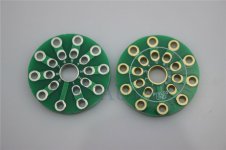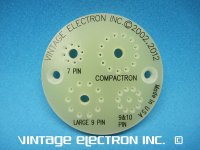The problem is exactly to find these tubes in europe.
The final choice will probably be the 6DQ5 (Vacuumtubes.net where I bought tubes a few times and everything went very well) if I can use the pcb's without foil cutting (is it possible ?), as in the case of 6LB6 where I can bolt the socket´s to the chassis and make the connections to the board.
Caetano
You could get in touch with Billington's here in the UK (see here). Their stock list is huge and they also have many item not even shown on it, so you need to send them a list of your requirements.
I have just bought a few rectifier valves and they could not have been more helpful. All the valves were NOS and tested on the day of dispatch to me. No affiliation just one satisfied customer!
I'm finally putting this thing to bed, a suggestion with regards to the MOSFET regulator, ripple eater and heat sink.
I made an angle of 3/32 aluminum to attach to the heatsink. Drill the mounting holes on the angle and attach the semi's and power resistor prior to soldering the devices (with thermal grease and insulator obviously) Mount the heat sink, slip the MOSFET leads into the appropriate holes and solder up.
Of course, I didn't do it this way on the first monoblock!
You can either thread the angle, or thread the heat sink. Of course, use thermal grease when attaching.
I made an angle of 3/32 aluminum to attach to the heatsink. Drill the mounting holes on the angle and attach the semi's and power resistor prior to soldering the devices (with thermal grease and insulator obviously) Mount the heat sink, slip the MOSFET leads into the appropriate holes and solder up.
Of course, I didn't do it this way on the first monoblock!
You can either thread the angle, or thread the heat sink. Of course, use thermal grease when attaching.
The 6HJ5 tubes for this amp have become rather hard to find. I just got a call from Stan at ESRC who told me that he will have over 100 of them in stock by Thursday and he wants $6 each.
I had them on my want list so he called me, but I have more of them than I need, and am currently working on something BIGGER, so I'm posting this here.
I had them on my want list so he called me, but I have more of them than I need, and am currently working on something BIGGER, so I'm posting this here.
If you order Hammonds from Hawk, they ship cheap, within the USA anyway. I got a pair of large power trans and 4 chokes shipped for $6.99 or so. Then a few weeks later I ordered a pair of 1650Ts, they shipped for $13.99. They also had the best prices I could find. They drop ship UPS from Hammond almost immediately. Don't blame me if they figure out they are losing money though! No affiliation, just my experience. Electro-Mechanical Components | Hawk ElectronicsTransformers are heavy.
jeff
Last edited:
The 6HJ5 tubes for this amp have become rather hard to find. I just got a call from Stan at ESRC who told me that he will have over 100 of them in stock by Thursday and he wants $6 each.
I had them on my want list so he called me, but I have more of them than I need, and am currently working on something BIGGER, so I'm posting this here.
i have a sleeve of those, these tubes with 30 watts plate require huge plate voltage if i recall...
tubes with 30 watts plate require huge plate voltage if i recall...
That depends on how much power you want from them. A pair of 6HJ5's will deliver 125 watts into a 3300 ohm OPT.....but it takes about 625 volts to get there.
Pete gets 50 watts from "407 volts." I'm guessing 500 volts gets you close to 100 watts.
I've been using some 7 and 9 pin tube adapter PCBs to change the pinouts of tubes. Like the 7CM base 6GU5/6CB6/8136/6EW6/5JK6 drivers to 9 pin tubes like 6JC6, 12HL7, 12BY7, 6197.
If we had a 12 pin Compactron PCB adapter, then any TV Sweep tube could be used on the original 50 Watt Monoblock PC Boards. The 1 mm pins are available on Ebay. Use a pin straightener to hold the pins in formation to solder to the adapter PCB. Then put a socket on a second adapter PCB and wire the two adapter PCBs together as needed. Of course, nothing wrong with using the original 6HJ5 tubes if you can find them.
If we had a 12 pin Compactron PCB adapter, then any TV Sweep tube could be used on the original 50 Watt Monoblock PC Boards. The 1 mm pins are available on Ebay. Use a pin straightener to hold the pins in formation to solder to the adapter PCB. Then put a socket on a second adapter PCB and wire the two adapter PCBs together as needed. Of course, nothing wrong with using the original 6HJ5 tubes if you can find them.
Attachments
Quick question as I couldn't find anything obvious. What is the input sensitivity of this 50w version? Can I assume it's similar to the original version (1.9v)? Reason I'm asking is that it's quite difficult to get reasonable/loud volume other than from a DAC or CDP with 2V-RMS output. Tuner, tape, and phono pre both have less output voltage. Using 87db speakers and a passive preamp.
Yes.
jeff
So I can assume input sensitivity is ~1.9v, or was this a silly "yes"?
If the N Fdbk resistors (local shunt Schade) are the same, then the output stage would have similar gain (except for 6HJ5 gm versus 6JN6 gm, and the different OT impedance ratio).
If global N Fdbk is installed (to the input stage) then the overall gain would be reduced.
And the input tube gm (6CB6 changed to 6GU5) would change the gain (without the global N Fdbk loop installed), but seems to just make up for the reduced sensitivity of the 6HJ5 (for increased power) versus the previous 6JN6. Some other high gm input (pin compatible) tubes: 6EW6 and 5/6JK6. 6EW6 has similar gm to the 6GU5, but probably more linear. 5/6JK6 has higher gm (will be louder). Some 5/6JK6 tubes have a hysteresis problem at high signal level, can be fixed with +30V on grid 3.
Yes, maybe, depends.
If global N Fdbk is installed (to the input stage) then the overall gain would be reduced.
And the input tube gm (6CB6 changed to 6GU5) would change the gain (without the global N Fdbk loop installed), but seems to just make up for the reduced sensitivity of the 6HJ5 (for increased power) versus the previous 6JN6. Some other high gm input (pin compatible) tubes: 6EW6 and 5/6JK6. 6EW6 has similar gm to the 6GU5, but probably more linear. 5/6JK6 has higher gm (will be louder). Some 5/6JK6 tubes have a hysteresis problem at high signal level, can be fixed with +30V on grid 3.
Yes, maybe, depends.
Last edited:
I am going to have a custom potted power transformer built which cosmetically will match my potted output transformers better. Just how over-spec is the Hammond 290FX for this power amp?
Hammond 290FX: (120V @ 60 Hz, 640Vct @ 518 mA 60V Bias, 6.5V @ 5.5A)
I am considering Silk Transformers and price goes up by the VA rating. For those getting custom potted power transformers built what ratings should we order for this amp with a safe amount of headroom? Also, at what milliamp rating is the 60v bias?
Hammond 290FX: (120V @ 60 Hz, 640Vct @ 518 mA 60V Bias, 6.5V @ 5.5A)
I am considering Silk Transformers and price goes up by the VA rating. For those getting custom potted power transformers built what ratings should we order for this amp with a safe amount of headroom? Also, at what milliamp rating is the 60v bias?
If you can possibly find just an aluminum shroud to put over the power transformer, that will keep in less heat than epoxy potting will.
Pete indicates 200mA DC and assuming you're using the full wave rectifier (not a bridge), then the AC high voltage current is about 300mA, so there's some headroom on the Hammond PT.
The 60V bias is just a tap on the primary winding usually, so you don't have to give any specs for that.
If you are wanting to use a very different power transformer with a bridge rectifier and a separate bias winding, you can just all out the winding as a bias winding.
Pete indicates 200mA DC and assuming you're using the full wave rectifier (not a bridge), then the AC high voltage current is about 300mA, so there's some headroom on the Hammond PT.
The 60V bias is just a tap on the primary winding usually, so you don't have to give any specs for that.
If you are wanting to use a very different power transformer with a bridge rectifier and a separate bias winding, you can just all out the winding as a bias winding.
I can see that Pete put this in the schematic on his site. Didn't realize this before and was just looking at the text that stated Hammond 290FX.
Pete's Schematic for mono dcpp:
640VCT 200mA DC
60V 20mA DC (I guess 20ma is actually needed on the bias tap?)
6.3V 5.5A
I'm not sure what this means since I'm just a hobbyist:
Pete's Schematic for mono dcpp:
640VCT 200mA DC
60V 20mA DC (I guess 20ma is actually needed on the bias tap?)
6.3V 5.5A
I'm not sure what this means since I'm just a hobbyist:
So do I need 200ma or 300ma for the the 640Vct? It's an expensive mistake to make if I order the wrong thing. Going from 640Vct @ 518 mA (331VA) to 640Vct @ 200 mA (128VA) is 203VA savings in both weight & price.Pete indicates 200mA DC and assuming you're using the full wave rectifier (not a bridge), then the AC high voltage current is about 300mA, so there's some headroom on the Hammond PT
Last edited:
I'm not sure what this means since I'm just a hobbyist: So do I need 200ma or 300ma for the the 640Vct? It's an expensive mistake to make if I order the wrong thing. Going from 640Vct @ 518 mA (331VA) to 640Vct @ 200 mA (128VA) is 203VA savings in both weight & price.
You will want to specify AC current, as saying 200mA of DC current won't indicate the load on the transformer without providing the electrical design and working backwards.
So "640V CT 300mA with a bias tap at 60V" would be what I would ask for.
- Home
- Vendor's Bazaar
- 50W monoblock "Engineers Amp"


